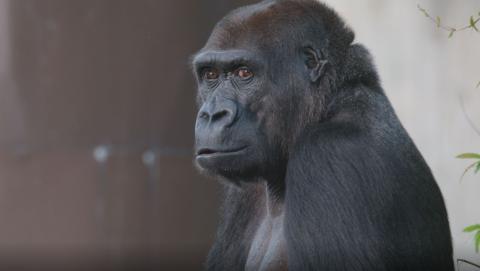News Archive
Filter By
- Abyssinian ground hornbill
- Addax
- Aldabra tortoise
- Allen's swamp monkey
- Alpaca
- American alligator
- American avocet
- American bison
- American flamingo
- American wigeon
- Andean bear
- Aquatic caecilian
- Arapaima
- Asian elephant
- Asian small-clawed otter
- Asian water dragon
- Australian snake-necked turtle
- Bald eagle
- Baltimore oriole
- Barred owl
- Bearded emperor tamarin
- Beaver
- Bennett's wallaby
- Binturong
- Black-and-white ruffed lemur
- Black-crowned night heron
- Black-footed ferret
- Black-tailed prairie dog
- Black-throated blue warbler
- Blue-billed curassow
- Blue crane
- Bobcat
- Brown pelican
- Bufflehead
- California sea lion
- Canvasback
- Cedar waxwing
- Channel catfish
- Cheetah
- Chicken
- Chinese alligator
- Chinese three-striped box turtle
- Clouded leopard
- Collared brown lemur
- Common raven
- Common yellowthroat
- Corals and sea anemones (anthozoa)
- Cow
- Crocodile monitor
- Cuban crocodile
- Dama gazelle
- Degu
- Dunlin
- Eastern indigo snake
- Eastern newt
- Eastern red-backed salamander
- Eastern screech-owl
- Eld's deer
- Electric eel
- Emperor newt
- Fennec fox
- Fishing cat
- Gaboon viper
- Geoffroy's marmoset
- Gharial
- Giant leaf-tailed gecko
- Giant panda
- Goat
- Golden-headed lion tamarin
- Golden lion tamarin
- Gray seal
- Gray wolf
- Green tree python
- Grevy's zebra
- Guam kingfisher (sihek)
- Guam rail (ko’ko’)
- Guinea pig
- Harbor seal
- Hartmann's mountain zebra
- Hawk-headed parrot
- Hellbender
- Home's hinge-back tortoise
- Hooded crane
- Iranian fat-tailed gecko
- Japanese giant salamander
- King vulture
- Komodo dragon
- Kori bustard
- Kunekune pig
- Land hermit crab
- Larger Malay mouse-deer
- Lemur leaf frog
- Lesser hedgehog tenrec
- Lesser kudu
- Lion
- Loggerhead shrike
- Long-tailed chinchilla
- Long-tailed salamander
- Maned wolf
- Meerkat
- Miniature donkey
- Naked mole-rat
- North American porcupine
- North American river otter
- Northern Luzon giant cloud rat
- Northern pintail
- Northern red salamander
- Northern snakehead fish
- Northern tree shrew
- North Island brown kiwi
- Norway rat
- Orangutan
- Orchard oriole
- Ossabaw Island hog
- Ostrich
- Ovenbird
- Pallas's cat
- Panamanian golden frog
- Patagonian mara
- Persian onager
- Philippine crocodile
- Prehensile-tailed porcupine
- Prevost's squirrel
- Przewalski's horse
- Pygmy slow loris
- Red-crowned crane
- Red-fronted lemur
- Red-rumped agouti
- Red-winged blackbird
- Red knot
- Red panda
- Red River hog
- Red ruffed lemur
- Red wolf
- Ring-tailed lemur
- Ruddy duck
- Schmidt's red-tailed monkey
- Scimitar-horned oryx
- Screaming hairy armadillo
- Semipalmated plover
- Semipalmated sandpiper
- Siamang
- Sitatunga
- Sloth bear
- Southern lesser galago
- Southern swamp sparrow
- Southern tamandua
- Spider tortoise
- Striped skunk
- Tanagers
- Tentacled snake
- Tiger
- Titi monkey
- Turkey
- Twig catfish
- Two-toed sloth
- Vietnamese mossy frog
- Virginia opossum
- Von der Decken's hornbill
- Western lowland gorilla
- White-cheeked gibbon
- White-faced saki
- White-naped crane
- White-nosed coati
- Whooping crane
Displaying 2026 - 2050 of 2362 articles.
Sumatran Tiger Update Apr 15, 2012
Guntur is officially the newest resident of Zoorasia in Yokohama, Japan! Guntur was sent there last week on a breeding recommendation with a female tiger that they have from Holland. As his keepers, we are all very sad to see him go, but we are excited that he will get the opportunity to increase...
Human-Modified Habitats Indirectly Influence Bird-Mating Patterns, Smithsonian Conservation Biology Institute Scientists Find
Birds provide one of the most common ways to encounter nature in cities, but few people wonder how their actions affect birds looking for love.
Smithsonian Scientist Uses Innovative Method to Predict How Forests Will Change Over Time
Many factors affect the future of forests, making it complicated to develop predictions about where they will disappear and where they will flourish, what types of trees they will include and how much carbon they will store in the years to come. In a paper published in this month's issue of...
Smithsonian Conservation Biology Institute Publishes Two Significant Panda Studies
Two new research papers by Smithsonian Conservation Biology Institute scientists and partners will help conservation biologists make strides in saving the fewer than 1,600 giant pandas left in the mountain forests of central China. Over the years SCBI has worked to conserve giant pandas by studying...
Black Howler Monkey Born at the Smithsonian's National Zoo
Spring is in full swing at the Smithsonian's National Zoo, and the Small Mammal House — which celebrated the birth of a black howler monkey (Alouatta caraya) March 22 — is no exception.
National Zoo Gorillas are the First to Participate in Heart Disease Study - Media Release
The same device used to detect early warning signs of heart disease in humans will now benefit two male sub-adult gorillas at the Smithsonian's National Zoo. Twelve-year-old Kwame and 10-year-old Kojo are the first western lowland gorillas ( Gorilla gorilla gorilla) to participate in a study lead by...

Facebook Users Get Chance to Name Two Maned Wolf Pups at the Smithsonian Conservation Biology Institute
Two of the four maned wolf pups born Jan. 5, 2012, at the Smithsonian Conservation Biology Institute in Front Royal, Virginia, are in need of names and for the first time the Smithsonian's National Zoo is turning to Facebook to find the most fitting monikers.
Sodexo Wins Foodservice Contract for the Smithsonian's National Zoo
Part of the mission of the Smithsonian National Zoological Park in Washington, D.C., is to provide exciting and enriching experiences for approximately 2 million annual local, national and international Zoo visitors. As the National Zoo's new foodservice partner, Sodexo, leader in Quality of Daily...
Elderly Oryx Dies at Smithsonian's National Zoo
The National Zoo's 21-year-old female scimitar-horned oryx ( Oryx dammah), Liberty, was euthanized this morning. A final pathology report will provide more information, but her health had been in decline for several months. National Zoo visitors can see two young male scimitar-horned oryx on exhibit...
On St. Patrick's Day, National Zoo Animals Find Treats at the End of the Rainbow
With St. Patrick's Day just around the corner, animals--and their keepers--at the Smithsonian's National Zoo's Cheetah Conservation Station got into the holiday spirit. Animal care staff and aides created enrichment items--a paper-Mache mouse and Leprechaun hat--for maned wolves Siete and Diamantina...
Tickets for ZooFari at the Smithsonian's National Zoo on Sale Now
Tickets are now on sale for ZooFari—D.C.'s foodie event of the year that drives diners wild. Food aficionados are invited to unleash their taste buds and sample delicious dishes from the area's finest restaurants and vintners. ZooFari, hosted by Friends of the National Zoo, will be held May 17 from...
Rare Guam Rails Hatch at the Smithsonian's National Zoo
As Washington, D.C's unseasonably warm winter turns into spring, a baby boom is underway at the Smithsonian's National Zoo. Two Guam rail (Gallirallus owstoni) chicks hatched March 3 and 4; they join six others in the Zoo's collection--three of which live at the Smithsonian Conservation Biology...
Sumatran Tiger Update Mar 15, 2012
It's official! Guntur will be leaving soon and going to Zoorasia in Yokohama, Japan. There is a young female there who was recommended as a breeding partner for Guntur. She is not related to any tigers in the USA, and Guntur is not related to any tigers in Japan, so this is really an excellent match...
Traditional Religious Beliefs Can Complement Scientific Conservation Efforts
Scientists working to promote conservation in cultures around the globe may have an ally closer than they realize. A new study from the Tibetan region of China suggests that traditional religions have real on-the-ground benefits for local biodiversity—in other words, that non-scientific motivations...
Lion Update Feb 28, 2012
Lion separations have been going smoothly, and we are ready to take the last step! Several weeks ago, Baruti, Aslan, and John started spending the night in their own set of dens, next to the females. Luke had moved a little farther away from the rest of the pride, but has been able to walk through a...
New Zealand Ambassador Names National Zoo Kiwi Chick
The third female brown kiwi that hatched at the Smithsonian's National Zoo Dec. 11 has a new moniker: Omana (pronounced oh-MAH-nah). Mike Moore, New Zealand Ambassador to the United States, named the kiwi in honor of his hometown, O-Manawatere, a township located southeast of Auckland. Omana's...
Make Waves with Project Blue Planet to Save the Oceans 2/21/2012
It's easy to feel small in the face of large environmental problems like oil spills or air and water pollution, but kids can make a big difference. How? By entering Project Blue Planet, a nationwide contest organized by the Smithsonian's National Zoo.
Adorable Maned Wolf Pups Get a Medical Exam
The four maned wolf pups born Jan. 5 at the Smithsonian Conservation Biology Institute in Front Royal, Va., received their first vaccinations Thursday during a routine medical exam. SCBI veterinary technician Lisa Ware worked with animal care staff to perform the exams, insert identification...
Smithsonian Scientist Finds Obesity Risk Factors in Young Marmosets
Childhood obesity is a serious concern, with more than 18 percent of American 4-year-olds considered obese. A new study of marmosets, small South American monkeys, indicates that obesity may begin very early in life and suggests that marmosets may be a helpful model for obesity in humans. In the...
National Zoo Animals Steal Hearts This Valentine's Day
Where is the love this Valentine's Day? At the Smithsonian's National Zoo! Cuban crocodiles and giant Aldabra tortoises at the Reptile Discovery Center feasted on heart-shaped treats prepared by the Zoo's Nutrition staff. In the Bird House, a blue-billed curassow couple, a red-and-green macaw named...
Celebrate Valentine's Day at the Smithsonian's National Zoo
Celebrate Valentine's Day at the Smithsonian's National Zoo on Saturday, Feb. 11.
Roche Supports the Smithsonian's National Zoo with Next-Generation Sequencing Instrument for Animal Conservation Research
Roche and the Smithsonian Conservation Biology Institute in Washington, DC announced today a collaboration agreement to use Roche's GS Junior benchtop sequencing system for research in SCBI's Center for Conservation and Evolutionary Genetics. SCBI's state-of-the-art genetics laboratory, based at the...
Looking for Indigo Snakes in Georgia
By Lauren Augustine, Reptile Discovery Center Keeper at the National Zoo Eastern indigo snakes, Drymarchon couperii, are the largest nonvenomous snake in North America. They live in a variety of habitats depending on the region. They are beautiful, uniformly black but in sunlight they are remarkably...
Top Ten Critter Cupids from the Smithsonian's National Zoo
Experts at the Smithsonian's National Zoo have proof that romance is not only for the warm and fuzzy; friskiness is a trait all animals share-be they furry, feathered or finned. Seduction techniques abound in the animal kingdom: Zoo staff recognize when reptiles are feeling rapturous and giant...
